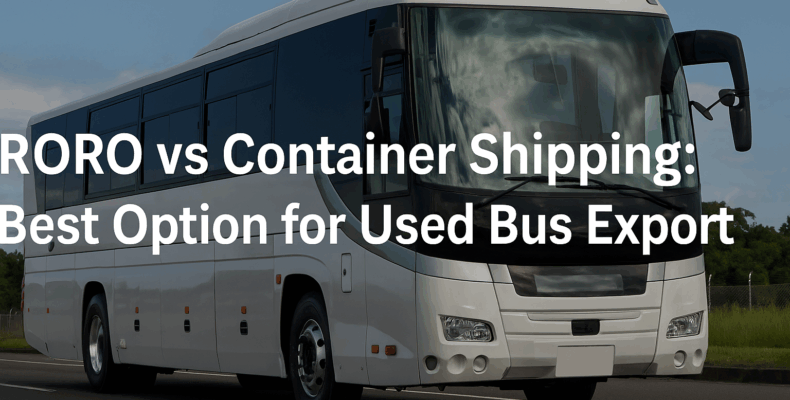When it comes to exporting used Japanese buses, global buyers and importers face a key question: Should you choose RORO (Roll-On/Roll-Off) or container shipping? Each method offers unique advantages depending on the size of the bus, shipping destination, and budget.
In this article, we break down the core differences between the two. Whether you are purchasing a full-size tourist coach or a compact commuter shuttle, understanding these methods helps you make a smart decision.
🚢 What Is RORO Shipping?
RORO (Roll-On/Roll-Off) is a method where the bus is driven directly onto a specialized ship and then driven off at the destination. It’s fast and ideal for large, running vehicles like full-sized buses.
✅ Key Benefits of RORO:
-
No disassembly required
-
Faster loading and unloading
-
Lower handling risk
-
Often more cost-effective for operable, full-size buses
❌ RORO Limitations:
-
Not available in all ports
-
Vehicle must be in driving condition
-
No option to include extra cargo inside the bus
📦 What Is Container Shipping?
Container shipping places the bus (or parts of it) inside a metal shipping container. This method is more common for smaller or non-running units.
✅ Advantages of Container Shipping:
-
Higher protection from weather and theft
-
Extra parts or cargo can be shipped together
-
Works for buses that are not drivable
-
Easier documentation in some countries
❌ Drawbacks of Container Shipping:
-
Higher cost for large buses
-
May require partial disassembly
-
Longer preparation and loading time
⚖️ RORO vs Container: When to Use Each
| Criteria | RORO Shipping | Container Shipping |
|---|---|---|
| Bus is drivable | ✅ Yes | ❌ Not required |
| Bus is oversized | ✅ Fits large buses easily | ❌ May not fit without cutting |
| Need for fast shipping | ✅ Quicker process | ❌ May take more time |
| Extra parts with the bus | ❌ Not allowed | ✅ Can be loaded in container |
| Weather protection needed | ❌ Open deck exposure | ✅ Fully enclosed |
| Destination port allows | ✅ Needed in select ports only | ✅ Available in most ports |
🌍 Which Regions Prefer Which Method?
-
Africa (e.g., Kenya, Tanzania): RORO is often preferred for cost and availability.
-
Caribbean and Pacific Islands: Container shipping is safer due to tropical weather.
-
Middle East: Depends on port facilities; RORO is growing in popularity.
-
Southeast Asia (e.g., Philippines): Container shipping is more common for older, non-running buses.
💡 Tips for First-Time Importers
-
Check port availability – Not every country has RORO terminals.
-
Inspect bus condition – If the engine doesn’t start, container shipping is the way to go.
-
Compare quotes – Some routes make RORO cheaper, while others favor container rates.
-
Ask the exporter – Japanese sellers often have good advice based on experience.
-
Consider documentation – RORO may have simpler customs clearance in some nations.
🔗 Trusted Exporter Recommendation
When importing used Japanese buses, choosing the right exporter is just as important as the shipping method. For peace of mind, quality service, and global experience, check out this guide:
👉 Top 5 Trusted Japanese Used Truck Exporters for Global Buyers
🏁 Final Thoughts
So, which is better: RORO or container shipping? The answer depends on your bus type, port access, and delivery timeline. For full-size, drivable buses, RORO often makes the most sense. For smaller or non-running vehicles—or when weather protection matters—container shipping is the smarter choice.
By understanding both options, international buyers can avoid costly mistakes and ensure a smooth import process. The goal is simple: get your Japanese used bus delivered safely, affordably, and on time.
